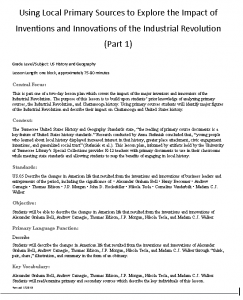This blog post was authored by Annie Dockery, an intern in the Library’s Special Collections unit from the UTC Department of English in Spring 2019.
By interning in Special Collections I appreciated that I was able to utilize both halves of my major, English and Education, while also delving into history, an area outside of my field. During the internship, I created four sets of lesson plans and handouts for history teachers to use. At the outset of the internship, I expected to create more lesson plans, but at the time I was unaware of the large number of artifacts I would need to find, sort through, and read. Each lesson plan fulfilled a Tennessee State standard while also teaching students about Chattanooga’s history by incorporating artifacts from Special Collections into the materials. Beyond teaching content, I had several skills I wanted my lesson plans to develop in students. I wanted to incorporate much group work to help students learn to work together towards a common goal, but also to enable students to lean on each other to work through difficult concepts instead of leaning on the instructor. As a future English teacher, I wanted each lesson to have a writing component and include a complex text. Additionally, since working with primary documents oftentimes gets overlooked in the classroom, I wanted most of the activities to center around students analyzing primary documents to piece together history and to draw conclusions about historical events and concepts.

Initially, I saw my lack of training in history as a huge challenge for the internship. I was not sure that I would be able to make effective history lesson plans with having taken few history courses. I did not expect to learn as much about national or local history as I did. Most of the primary sources I encountered were full of valuable information and perspectives on the time. I had to sort through large quantities of primary documents, just to find one that fit the State Standard and was readable for students. I learned an incredible amount from reading and looking at all of these artifacts, not only the ones I chose to include in the lesson plans. My internship in Special Collections has been the best course in history I have ever taken.
Another challenge I faced was that I was taking my education course that covered how to write lesson plans at the same time as the internship. Because of this, I had to work ahead of my peers, asking my professor questions and doing some of my own research to help me complete my work in Special Collections. The lesson plans I made for Special Collections turned out to be great practice in writing lesson plans, and I became much faster at creating them due to this practice.
Before interning in Special Collections, I was not sure what archival work was. Although my work was a little outside of typical archival work, I learned that the field requires strong organizational skills, unique preservation methods, and competency in a variety of technologies. However, my piece showed me how challenging, but valuable it is to work to get archival materials off of the shelves and into the hands of the public, whether through physical or digital means.